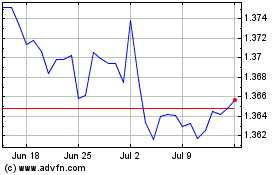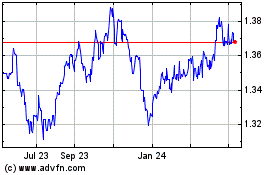U.S. Dollar Drops Against Majors
March 13 2017 - 12:25AM
RTTF2
The U.S. dollar drifted lower against its major rivals on
Monday, in tandem with a slump in treasury yields, as traders
resorted to profit taking in the wake of mixed U.S. jobs data on
Friday.
The benchmark yield on 10-year note fell 2.5 percent, while that
of the 2-year equivalent was down by 1.3 percent. Yields move
inversely to bond prices.
Although the U.S. job growth was solid in February, monthly
wages rose just 2 percent, weaker than forecasts for 3 percent
growth.
Even though the report is supportive of a March tightening, the
odds of a second hike dropped, as falling wages are likely to
dampen inflation expectations.
The U.S. Federal Open Market Committee will begin its 2-day
meeting on Tuesday, with a decision expected at 2 pm ET Wednesday.
Although a 25 basis-point hike is already priced in, investors
closely await the accompanying statement to gauge the likelihood of
additional rate hikes in the months ahead.
The currency was lower on Friday following the release of U.S.
monthly jobs data. It declined 0.1 percent against the yen, 0.2
percent against the franc, 0.9 percent against the euro and 0.01
percent against the pound for the day.
The greenback slid to 1.0714 against the euro, its weakest since
February 8. On the downside, 1.085 is possibly seen as the next
support level for the greenback.
The greenback that closed Friday's trading at 114.78 against the
Japanese yen weakened to a 4-day low of 114.51. If the greenback
extends fall, it may target 112.5 as the next support level.
Figures from the Ministry of Economy, Trade and Industry showed
that Japan's tertiary activity index remained unchanged in January,
after falling in the previous month.
The tertiary activity index showed no variations from December,
when it dropped by 0.3 percent. Meanwhile, economists had expected
a 0.1 percent slight rise for the month.
The greenback declined to a 6-day low of 1.2240 against the
pound, down from last week's closing value of 1.2164. The next
possible support for the greenback may be located around the 1.235
region.
Figures from Acadata and LSL showed that UK house prices
increased at their fastest pace in twelve months in February.
House prices grew 0.6 percent in February from January driven by
higher London prices. Average house prices totaled GBP 297,832.
The greenback fell to multi-day lows of 0.6950 against the kiwi
and 0.7588 against the aussie, compared to last week's closing
values of 0.6922 and 0.7535, respectively. Further downtrend may
lead the greenback to support levels of around 0.72 against the
kiwi and 0.775 against the aussie.
The greenback retraced its early gains against the loonie,
weakening to 1.3439. The greenback is seen finding support around
the 1.30 mark.
On the flip side, the greenback bounced off from an early nearly
2-week low of 1.0065 against the Swiss franc, with the pair trading
higher at 1.0117. The greenback is poised to target resistance
around the 1.03 zone.
Looking ahead, European Central Bank President Mario Draghi is
expected to deliver opening remarks at a joint conference organized
by the European Central Bank and Massachusetts Institute of
Technology, in Frankfurt at 10:30 am ET.
In the New York session, U.S. labor market conditions index for
February is set to be published.
At 8:45 am ET, European Central Bank board member Sabine
Lautenschlaeger is expected to speak in Dublin.
US Dollar vs CAD (FX:USDCAD)
Forex Chart
From Mar 2024 to Apr 2024

US Dollar vs CAD (FX:USDCAD)
Forex Chart
From Apr 2023 to Apr 2024
